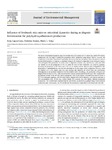Mostrar o rexistro simple do ítem
Influence of feedstock mix ratio on microbial dynamics during acidogenic fermentation for polyhydroxyalkanoates production
| dc.contributor.author | Lagoa Costa, Borja | |
| dc.contributor.author | Kennes, Christian | |
| dc.contributor.author | Veiga, María Carmen | |
| dc.date.accessioned | 2022-03-16T13:15:14Z | |
| dc.date.available | 2022-03-16T13:15:14Z | |
| dc.date.issued | 2021-12-01 | |
| dc.identifier.citation | Lagoa-Costa, B., Kennes, C., Veiga, M.C., 2022. Influence of feedstock mix ratio on microbial dynamics during acidogenic fermentation for polyhydroxyalkanoates production. Journal of Environmental Management 303, 114132. https://doi.org/10.1016/j.jenvman.2021.114132 | es_ES |
| dc.identifier.issn | 0301-4797 | |
| dc.identifier.uri | http://hdl.handle.net/2183/30027 | |
| dc.description | Financiado para publicación en acceso aberto: Universidade da Coruña/CISUG | es_ES |
| dc.description.abstract | [Abstract] The nature of microbial populations plays an essential role in the production of volatile fatty acids (VFA) during acidogenesis, the first stage in polyhydroxyalkanoates (PHA) production using mixed cultures. However, the composition of microbial communities is generally affected by substrate alterations. This work aimed to unravel the microbial dynamics in response to a gradual change in the feedstock composition in an acidogenic reactor, with subsequent PHA production. To achieve this, co-digestion of cheese whey and brewery wastewater (BW) was carried out for the production of VFA, in which the ratio of these feedstocks was varied by gradually increasing the proportion of BW from 0 up to 50% of the organic content. Bacteria such as Megasphaera, Bifidobacterium or Caproiciproducens were the most abundant in the first stages of the co-digestion. However, when BW reached 25% of the organic load, new taxa emerged and displaced the former ones; like Selenomonas, Ethanoligenens or an undefined member of the Bacteroidales order. Accordingly, the production of butyric acid dropped from 52 down to 27%, while the production of acetic acid increased from 36 up to 52%. Furthermore, the gradual increase of the BW ratio led to a progressive drop in the degree of acidification, from 72 down to 57%. In a subsequent approach, the VFA-rich streams, obtained from the co-digestion, were used as substrates in PHA accumulation tests. All the tests yielded similar PHA contents, but with slightly different monomeric composition. The overall results confirmed that the microbiome was altered by a gradual change in the feedstock composition and, consequently, the VFA profile and the monomeric composition of the biopolymer also did. | es_ES |
| dc.description.sponsorship | The current investigation has been financially supported by both the Spanish Ministry of Science and Innovation and European FEDER funds (PID2020-117805RB-I00 project). The authors, belongin to the BIOENGIN group, thank Xunta de Galicia for financial support to Competitive Reference Research Groups(ED431C 2021/55). B. Lagoa-Costa would also like to thank the financial contribution of INDITEX Group and the technical support of Dr. Ben Allen and Dr. Tom P. Curtis, from Newcastle University, during his internship. Funding for open access charge was provided by Universidade da Coruña/CISUG | es_ES |
| dc.description.sponsorship | Xunta de Galicia; ED431C 2021/55 | es_ES |
| dc.language.iso | eng | es_ES |
| dc.publisher | Elsevier | es_ES |
| dc.relation.uri | https://doi.org/10.1016/j.jenvman.2021.114132 | es_ES |
| dc.rights | Atribución-NoComercial-SinDerivadas 3.0 España | es_ES |
| dc.rights.uri | http://creativecommons.org/licenses/by-nc-nd/3.0/es/ | * |
| dc.subject | Anaerobic digestion | es_ES |
| dc.subject | Ethanol | es_ES |
| dc.subject | Feedstock change | es_ES |
| dc.subject | Microbial dynamics | es_ES |
| dc.subject | Polyhydroxyalkanoates | es_ES |
| dc.subject | Volatile fatty acids | es_ES |
| dc.title | Influence of feedstock mix ratio on microbial dynamics during acidogenic fermentation for polyhydroxyalkanoates production | es_ES |
| dc.type | info:eu-repo/semantics/article | es_ES |
| dc.rights.access | info:eu-repo/semantics/openAccess | es_ES |
| UDC.journalTitle | Journal of Environmental Management | es_ES |
| UDC.volume | 303 | es_ES |
| UDC.startPage | 114132 | es_ES |
Ficheiros no ítem
Este ítem aparece na(s) seguinte(s) colección(s)
-
GI-BIOENGIN- Artigos [91]






